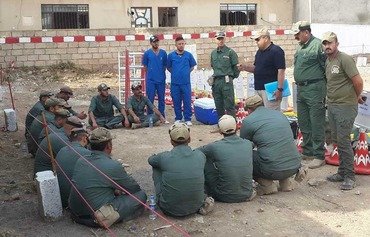The explosive remnants of war left behind by the "Islamic State of Iraq and Syria" (ISIS) litter vast swathes of Mosul, particularly on the western side of the city, and constitute an imminent danger for residents.
To mitigate this risk and pave the way for the residents of liberated neighbourhoods to return, the Iraqi government is working with local partners to clear the area so that reconstruction work can begin in earnest.
Explosive material, most of which is in the form of ordnance of varying sizes, is ubiquitous throughout the streets of Mosul.
"There is hardly any area in the city that is without such remnants," Iraqi Landmine Affairs Directorate head Khalid Rashad told Diyaruna.
Pollution from such remnants is extremely high, he added, noting that "it is difficult right now to accurately pinpoint the number and location of the ordnance".
After east Mosul was liberated, "we started engineering work with the Ministry of Defence and our partners to remove ordnance", he said, with clearance operations commencing in residential areas and at power generation and service stations.
Areas being tackled first include those with large populations of returning internally displaced persons (IDPs), he said, and densely populated areas such as Hammam al-Alil and al-Qayyarah.
Teams now clearing western areas
"Currently, we are working on the western side, as our expert teams conduct preliminary technical surveys to identify the level of pollution from ordnance and where it is concentrated," Rashad said.
The task is dependent upon "operational criteria that do not allow engineering teams to work randomly or hurriedly or to rush in without requisite calculations", he said. "We are trying to be cautious, since handling and defusing explosives is not easy."
Rashad noted that improvised explosive devices (IEDs) of varying sizes -- made by ISIS using primitive tools and materials -- are the most difficult and dangerous ordnance to handle.
These "may differ in size and in the explosive materials used or how they are detonated, depending on the manufacturer", he said. "Each one of them requires utmost attention and knowledge to defuse, so as not to cause casualties."
The teams have destroyed thousands of IEDs across entire areas, he said, which were particularly concentrated in corridors used by fleeing families and the enemy’s defence lines.
"We are working non-stop and will fulfill our duty as soon as possible," he said.
Working together to clear the city
Local partners are working under the supervision of the Iraqi Landmine Affairs Directorate, including al-Fahd company, which specialises in ordnance removal and the neutralisation of unexploded bombs.
This company has succeeded in clearing several minefields in eastern and southern Mosul, including Hammam al-Alil Hospital, the gas station in the village of Azba, and al-Aqrab security checkpoint on the highway to Baghdad.
Al-Fahd company general manager Mohamed Attia told Diyaruna his firm also has assessed the level of pollution from ordnances in 16 residential areas
"We are still working on clearing the University of Mosul and several schools, health centres and sanitation and power plants on the east side of the city, in addition to the cement plant in Hammam al-Alil," he said.
"We start with geographical surveys to identify the polluted areas, and after that we destroy the remnants, working with the Ministry of Defence," he added.
West Mosul is 'a huge minefield'
Attia said the teams recently moved into Mosul's western neighbourhoods, where they have begun survey and reconnaissance work.
"We conducted a preliminary survey to identify the volume of explosive pollutants in eight residential areas," he said, the results of which revealed that 75% of these areas were contaminated.
"We will spare no effort in providing a safe environment for the residents of Mosul and to confront this threat," Attia said.
ISIS turned the western side of Mosul into a "huge minefield", Ninawa provincial council member Khalaf al-Hadidi told Diyaruna.
"ISIS elements planted their landmines in roads, alleyways and inside people’s homes, especially the old parts of the city," he said, with the aim of slowing the progress of the liberating forces and inflicting heavy civilian losses.
"Explosive remnants and landmines are a serious source of concern, as safety and reconstruction can not be implemented unless they are cleared," he said. "However, we are confident in the ability of the government to overcome this challenge."

![Landmine experts defuse ordnance planted by the 'Islamic State of Iraq and Syria' at Mosul General Hospital. [Photo from the Iraqi Landmine Affairs Directorate Facebook page]](/cnmi_di/images/2017/06/16/8338-Iraq-Mosul-explosives-600_384.jpg)






